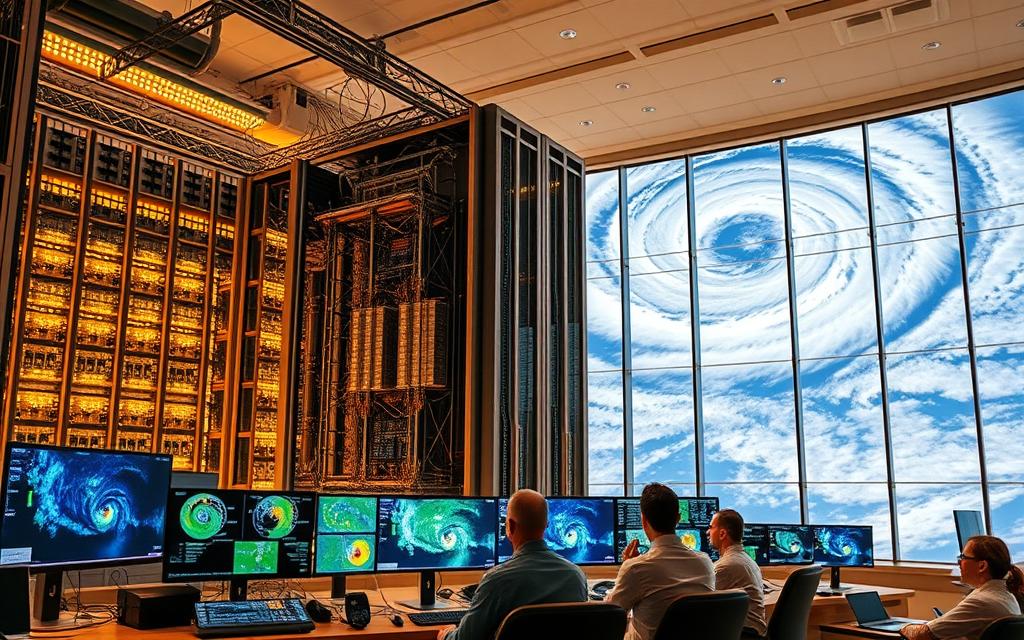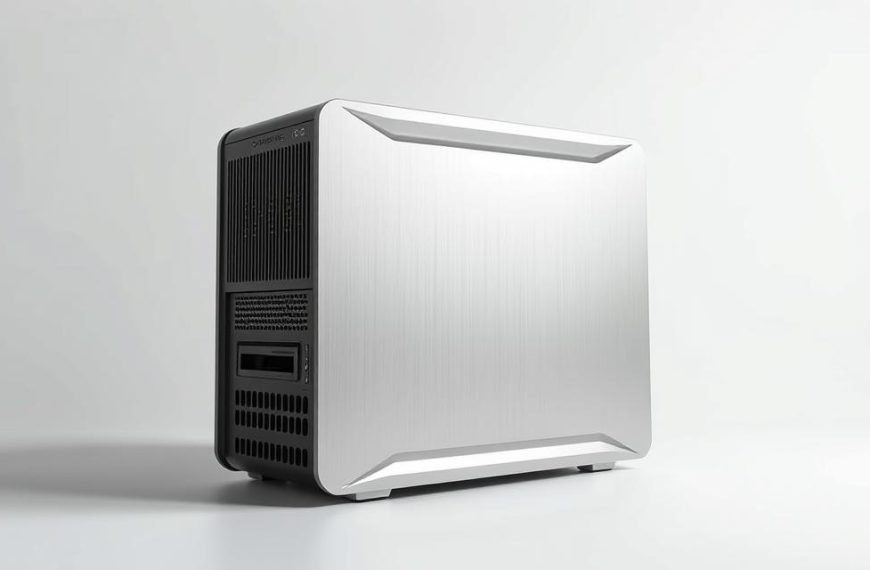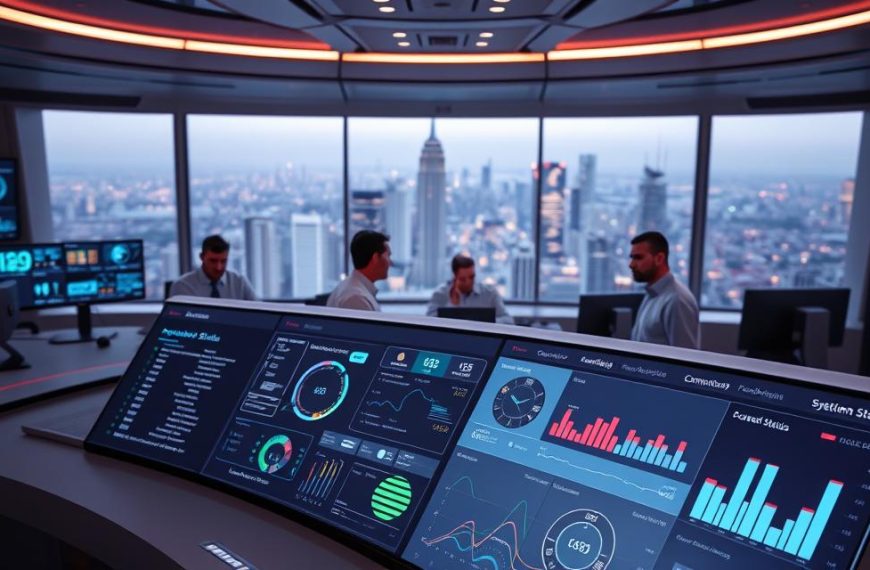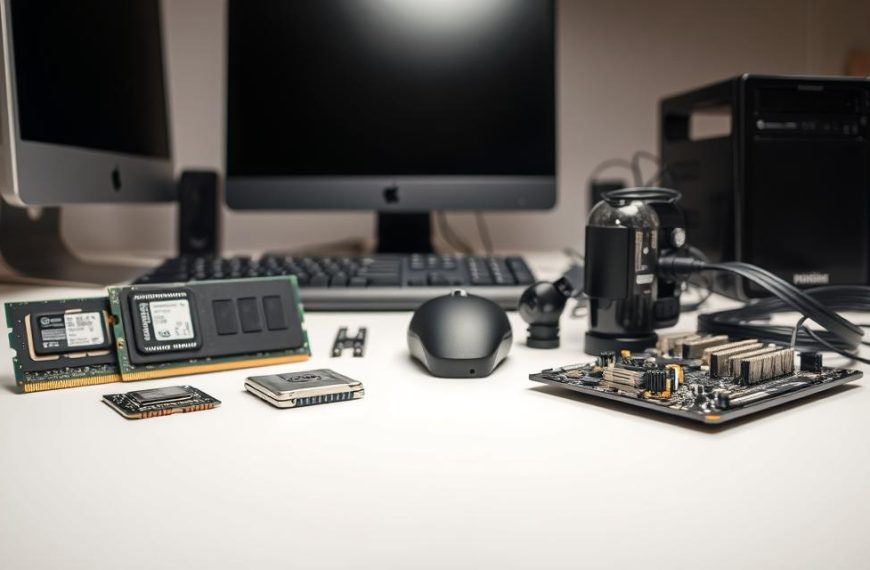Meteorology has changed a lot from Lewis Fry Richardson’s 1922 idea. He wanted a “forecast factory” with human calculators. Now, we use computers for predicting the weather.
In 1965, the UK Met Office made its first computer forecast. This was a big step in computational meteorology. It showed how computers could solve the big math problems of weather.
Now, weather modelling and climate science are different. Weather forecasts look at short-term changes. Climate models look at long-term trends over decades.
Today’s supercomputers can handle huge amounts of meteorological data. They use complex calculations on three-dimensional grids. This is explained in research on computing the weather.
The move from manual to supercomputer is a big step in climate science. It makes accurate forecasts possible. Without computers, these predictions would be impossible for humans to do.
The Complexity of Modern Meteorological Data Collection
Today’s weather forecasts use a complex network of systems. They collect data from all over our atmosphere. This network goes from the ground up to space, giving us a full view of the weather.
Diverse Data Sources and Measurement Systems
Meteorologists use many tools to get atmospheric data. They have old systems like automated weather stations and weather balloons. They also use new tech like Doppler radar and satellites.
Ground systems include:
- Automated Weather Stations (AWS) measuring temperature, humidity and pressure
- Doppler radar systems tracking precipitation and wind patterns
- LiDAR and SODAR instruments analysing atmospheric particles and sound waves
Marine data comes from buoys, and the upper atmosphere from satellites and planes. This mix ensures we get a full picture of the atmosphere.
Real-time Data Acquisition Challenges
Getting weather data is a big technical challenge. We need fast processing and smart ways to mix the data.
Satellite and Radar Information Processing
Satellite technology gives us a lot of data fast. Agencies like NOAA and EUMETSAT use many satellites. They watch clouds, sea temperatures, and more.
Doppler radar systems also need quick processing. They track rain, wind, and storms. They use special algorithms to understand the data.
Ground Station Network Integration
Connecting data from thousands of automated weather stations is hard. Each station must be set up the same way for accurate data.
National weather services must combine all this data. They do this by:
- Checking data quality
- Aligning measurements in time and space
- Filling in gaps with statistical methods
This must happen fast for real-time data analysis. It gets even harder when adding data from other countries. They need common standards and constant checks.
Why Are Computers Widely Used for Modeling Weather Systems
Modern weather forecasting uses advanced computers to turn raw data into accurate forecasts. The job of atmospheric modelling is so complex that it needs special computers. These computers can handle huge amounts of maths.
Mathematical Model Implementation Requirements
Weather prediction has changed from simple forecasts to detailed maths models. This change means using complex algorithms to mimic the atmosphere’s behaviour with high accuracy.
Numerical Weather Prediction Algorithms
Numerical weather prediction is key to today’s forecasting. These algorithms split the atmosphere into three-dimensional grids. They then calculate changes at each point over time.
The European Centre for Medium-Range Weather Forecasts uses a global grid with 9km resolution and 137 vertical layers. This setup means billions of calculations that need to be done at once.
Atmospheric modelling solves complex hydrodynamic equations that describe fluid motion. These equations are based on physical laws that govern the atmosphere.
Each calculation at a grid point involves solving many equations at once. The more detailed the grid, the more calculations are needed.
Massive Computational Resource Demands
The maths behind weather modelling is incredibly complex. Only the most powerful computers can handle these calculations quickly.
Parallel Processing Architectures
Parallel processing helps weather models by splitting calculations among many processors. This makes complex simulations much faster.
Today’s systems use thousands of processing cores to handle grid calculations. This lets them work on different parts of the atmosphere at the same time.
High-performance Computing Systems
Meteorological organisations worldwide use HPC systems for weather forecasting. These supercomputing facilities are among the most powerful computers around.
The ECMWF’s computing setup handles petabytes of data every day. This huge capacity helps make their medium-range forecasts more accurate.
Weather services keep improving their computing power to get better at forecasting. This constant push for better technology drives innovation in meteorological supercomputing.
Key Applications in Contemporary Weather Forecasting
Today, computer models play a big role in many areas. They help keep us safe and plan for the future. These systems change how we deal with weather.
Global Climate Change Modelling
Climate change models look at weather over many years. They need special ways to work, looking at the atmosphere, oceans, land, and ice.
These models help scientists understand:
- Long-term temperature trends and warming patterns
- Sea-level rise projections and coastal impact assessments
- Carbon cycle dynamics and greenhouse gas effects
- Ecosystem responses to changing climate conditions
They guide global policies and help us protect the environment.
Severe Weather Event Prediction
Advanced models warn us about dangerous weather. They save lives and protect property. These are key weather forecasting applications.
Hurricane and Cyclone Tracking Systems
NOAA uses advanced systems to track storms. They predict where storms will go and how strong they’ll be. These models use:
- Real-time satellite imagery and ocean temperature data
- Atmospheric pressure measurements across affected regions
- Historical storm pattern analysis for improved accuracy
- Ensemble forecasting to account for prediction uncertainties
They give us time to prepare before storms hit.
Extreme Precipitation Forecasting
Flood models look at moisture, storm paths, and ground saturation. They help predict:
- Flash flood risks in urban and rural areas
- River level changes and overflow points
- Landslide risks in mountainous regions
- Coastal flooding during storm surge events
They help emergency services get ready for bad weather.
Specialised Sector Applications
Computer models also help specific industries. This sector-specific meteorology is very advanced.
Aviation Weather Services
Weather info is key for safe flying. Models provide:
- Turbulence forecasts along flight routes
- Icing condition predictions at various altitudes
- Wind shear detection near airports
- Volcanic ash cloud tracking and dispersion modelling
They help pilots avoid dangers and save fuel.
Agricultural Meteorology Programs
Farmers use weather models for planting and harvesting. These programs offer:
- Frost and freeze warnings for crop protection
- Drought condition monitoring and irrigation guidance
- Disease risk forecasts based on weather conditions
- Growing degree day calculations for crop development
As we discussed in our article on computer weather models, these apps meet specific needs.
“The advancement of sector-specific weather modelling has transformed how industries approach risk management and operational planning, creating more resilient business practices across numerous sectors.”
Computer models help us understand climate and warn us about storms. They protect communities and support businesses worldwide.
Technological Advancements Driving Meteorological Progress
Technology has changed weather forecasting a lot. Now, we use advanced computers and artificial intelligence for better accuracy.
Supercomputing Capabilities Evolution
Computers have come a long way from simple systems to today’s supercomputers. This change has made weather modelling more complex and accurate.
Historical Development of Weather Computers
In the 1960s, weather computing started with systems like the IBM 7090. These early machines could do basic math but not much more.
In the 1970s and 1980s, weather computers got better. The Cray supercomputers of the 1980s were a big step forward in weather computing.
Modern High-performance Computing Centres
Today, meteorological centres use the world’s most powerful supercomputers. They handle huge amounts of data every day to make forecasts.
The European Centre for Medium-Range Weather Forecasts has a massive supercomputer. It does quadrillions of calculations per second for global weather forecasts.
| Era | Computing System | Processing Power | Forecast Capability |
|---|---|---|---|
| 1960s | IBM 7090 | 0.1 MFLOPS | Basic calculations |
| 1980s | Cray-1 | 160 MFLOPS | Regional models |
| 2000s | Cluster systems | 10 TFLOPS | Global models |
| Present | Modern HPC | 100+ PFLOPS | High-resolution global modelling |
Artificial Intelligence Integration
Artificial intelligence has changed weather forecasting a lot. AI systems can identify patterns that humans might miss.
IBM has led the way in using AI for weather prediction. Their technology can handle huge datasets better than old systems.
Machine Learning in Pattern Recognition
Machine learning algorithms are great at finding complex patterns in the atmosphere. They learn from past data to spot weather patterns.
Research is using machine learning to improve how data is used in weather models. This makes weather forecasts more accurate.
Neural Networks for Improved Predictions
Neural networks are at the forefront of predicting the weather. They can handle many types of data at once for better forecasts.
Scientists have made neural networks that are good at predicting severe weather. These systems are very promising for forecasting extreme weather events.
Conclusion
Computers are key to modern weather forecasting. They handle huge amounts of data and run complex maths. But, they face big challenges like needing lots of resources and dealing with poor data quality.
These problems push scientists to keep improving. They aim to make weather predictions better. This is a big challenge, but it’s making a difference.
The future of weather forecasting looks good. New tech like artificial intelligence and better models are on the horizon. These will help make predictions more accurate.
They will give us better warnings for bad weather and help us understand the climate better. This means meteorology will keep getting better.
As computers get more powerful, so does our ability to forecast the weather. The link between tech and meteorology is strong. It means weather forecasting will get more precise and useful for everyone.

















